
doi.org/10.15198/seeci.2019.50.43-72
RESEARCH
KEY COMPETENCES OF UNIVERSITY STUDENTS FOR THE USE OF ICT
COMPETENCIAS CLAVES DE LOS ESTUDIANTES UNIVERSITARIOS PARA EL USO DE LAS TIC
HABILIDADES CHAVES DOS ESTUDANTES UNIVERSITARIOS PARA O USO DE TIC
María Eugenia Bello van der Ree1
Juan Antonio Morales Lozano2
1Metropolitan University. Venezuela. She is currently Dean of General and Basic Training, was Director of the School of Education at the Metropolitan University in Caracas, Venezuela.
mabello@unimet.edu.ve
2Sevilla University. Spain
jamorales@us.es
ABSTRACT
The objective of the present study is to describe the profile of key competences required by the University student of pedagogy for the use of the technologies of information and communication, in the city of Caracas, Venezuela. The methodology consists of a descriptive field study, ex post facto, cross. It is a list of 54 skills to study, for which the participation of twenty-nine teachers, 30 employers and three hundred and eighty-five students was achieved over a period of nine months at six universities. A mixed, partly quantitative and some qualitative approach was used for the analysis of the data as well as descriptive statistics in order to describe the competence of students for the use of the Information and communication technologies. The overall results indicate that three samples mostly considered as very important competencies, finding some differences in the development of the same. The study of correlations between populations reflects that there are similarities in the trend as they perceive competitions, but no correlation between populations. It is considered that the results are consistent in the sense that all say exactly the same. Finally, there is motion for a competency profile key that requires the student of pedagogy for the management of ICT, which could be considered in future designs of curricula and teacher training programs.
KEY WORDS: profile, competences, Information and Communication Technologies, curriculum, plan of study, students, curriculum design
RESUMEN
El objetivo del presente trabajo es describir el perfil de competencias claves que requiere el estudiante universitario de la carrera de Pedagogía para el uso de las Tecnologías de la Información y la Comunicación, en la ciudad de Caracas, Venezuela. La metodología consiste en un estudio de campo, descriptivo, ex post facto, transversal. Se presenta un listado de 54 competencias a estudiar, para lo cual se logró la participación de veintinueve docentes, treinta empleadores y trescientos ochenta y cinco estudiantes durante un período de nueve meses en seis universidades. Para el análisis de los datos se utilizó un enfoque mixto, en parte cuantitativo y en parte cualitativo, es decir estadística descriptiva, frecuencia y porcentaje para las preguntas cerradas, y para las preguntas de carácter abierto se llevó a cabo un análisis de contenido de acuerdo a su relación con el marco teórico, con el objeto de describir las competencias de los estudiantes para el uso de las Tecnologías de la Información y la Comunicación. Los resultados generales señalan que las tres muestras consideran en su mayoría las competencias como muy importantes, encontrando algunas diferencias en cuanto al desarrollo de las mismas. El estudio de correlaciones entre las poblaciones refleja que hay similitudes en cuanto a la tendencia como perciben las competencias, pero sin ninguna correlación entre las poblaciones. Por lo que se considera que los resultados son coherentes en el sentido de que todos dicen exactamente lo mismo. Finalmente, se presenta propuesta de perfil de competencias claves que requiere el estudiante de la carrera de Pedagogía para el manejo de las TIC, el cual podría ser considerado en futuros diseños de planes de estudio y programas de formación de docentes.
PALABRAS CLAVE: perfil, competencias, Tecnologías de Información y Comunicación, currículum, plan de estudio, estudiantes, diseño curricular
RESUME
O objetivo do presente trabalho e descrever o perfil de habilidades chaves que requer o estudante universitário da matéria de Pedagogia para o uso das Tecnologia da Informação e da Comunicação, na cidade de Caracas, Venezuela. A metodologia consiste em um estudo de campo, descritivo, ex post fato, transversal. Se apresenta uma lista de 54 habilidades a estudar, para o qual logrou a participação de 29 docentes, 30 empregados e 385 estudantes durante um período de 9 meses em 6 universidades. Para a analises dos dados se utilizo um enfoque misto, em parte quantitativo e em parte qualitativo, que dizer estadística descritiva, frequência e porcentagem para as perguntas fechadas, e para as perguntas de caráter aberto foi feito um analise de conteúdo de acordo a sua relação com o marco teórico, com o objetivo de descrever as habilidades dos estudantes para o uso das Tecnologias da Informação e Comunicação. Os resultados gerais assinalam que as três amostras consideram em sua maioria as habilidades como muito importantes, encontrando algumas diferenças enquanto ao desenvolvimento das mesmas. O estudo de correlações entre as populações reflete que há similitudes enquanto a tendência como percebem as habilidades, mas sem nenhuma correlação entre as populações. Pelo que se considera que os resultados são coerentes no sentido de que todos dizem exatamente o mesmo. Finalmente, se apresenta proposta de perfil de habilidades chaves que requer o estudante de Pedagogia para o manejo das T.I.C., o qual poderia ser considerado em futuros desenhos de planos de estudo e programas de formação de docentes.
PALAVRAS CHAVE: perfil, habilidades, TIC, curriculum, plano de estudo, estudantes, desenho curricular
How to cite the article: Bello van der Ree, M. E. & Morales Lozano, J. A. (2019). Key competences of university students for the use of ICT. [Competencias claves de los estudiantes universitarios para el uso de las TIC]. Revista de Comunicación de la SEECI, (50), 43-72. doi: http://doi.org/10.15198/seeci.2019.50.43-72
Recovered from http://www.seeci.net/revista/index.php/seeci/article/view/603
Received: 31/05/2019
Accepted: 26/06/2019
Published: 15/11/2019
1. INTRODUCTION
The arrival of educational technologies determines training of a student with a different profile, with a new design of the educational model, because they are directly impacting society, specifically the individual and their daily development in life, this includes the personal and labor levels. In terms of technology, the global advance is enormous, we create spacecraft, biotechnology, genetic engineering, lasers, satellites, supercomputers, interactive TV, artificial engineering, nanotechnology, 3D printers, virtual reality games, touch screens, smart phones, which leads us to analyze: What has happened to education?, What changes are necessary?, What are the new educational approaches?, What are the competencies that the user requires for the use of technology?
The incessant scientific advances in all fields of knowledge and their respective technological developments are providing us with new and powerful instruments to carry out our work. The advances in science and technology that could change our lives such as the driverless cars or genetic engineering, it is necessary to keep them in mind when designing syllabuses.
Authors such as Govantes, 2001; Cabero et al. 2000; Castañeda, s/f; Belloch, 2000; BBC, 2018; agree that all these changes and transformations, which have occurred so quickly in all fields of modern life, are something that characterizes the world in which we live.
It is known that those people who do not have the basic skills in ICT, that is, who do not know how to read through digital sources of information such as web pages, TV channels, cyber libraries, media libraries, among others, and do not know how to write with text editors, communicate through telematic channels or use the Web2.0 will be considered illiterate and be at a disadvantage to develop in society and in their different professions, especially teachers who will need these skills for their pedagogical practice.
Hence the importance of universities taking into account digital literacy and ICT integration in the syllabuses, so that their graduates achieve their participation in all political, economic and social strata, in keeping with the challenges our society.
Authors like Cabero, J., Castaño, C., Cebreiro, B., Gisbert, M., Martínez, F., Morales, J., Prendes, M., Romero, R. and Salinas, J. (2003); Belloch (2000), and Cabero (2003), as well as in the Horizon Report (2017) agree that the student’s role is that of an autonomous individual who investigates and reflects about his teaching-learning process. Adding that students need digital literacy that allows them to effectively and efficiently use these new technological instruments that ICT make up in their activities as students and as future professionals. So students need instrumental skills to use Internet programs and resources, but even more relevant is the fact that the education student requires didactic skills for the use of ICT in their different professional roles that they will have to experience.
The training of students in relation to the use of new technologies requires clarifying the policies and programs developed for this purpose and also framing them in higher education institutions, of a changing society, where the students’ conception and their new profile are faced attending to the demand of integration of the ICT in the educational context.
Alva (2003), as well as Ojeda, Pino-Juste and Soto (2017) and García and Lorente (2017) add that the student must now be an active element in the process of acquiring knowledge. It is important that the new educational model has, as a central axis of learning: motivation, problem solving and collaborative work. The ability to work in groups, based on defined projects, is also of great importance in the new economic and social context.
The student in the 21st century should be:
In relation to the rationale for Information and Communication Technologies, the concept, its characteristics, its advantages and disadvantages, the policies in Venezuela in relation to the subject, the means applied to education, monitoring and evolution were reviewed. Authors such as García and Lorente (2017); Castaño, (Coord., 2009); Cabero (2001, 2006, 2007, 2008); Cabero and Gisbert (2008); Cabero, Salinas, Duarte, Domingo (2000); Sevillano (2002); López (2001); Area (2002); García (2001); Valdés (2000); Escudero (2004); Cabero, Castaño, Cebreiro, Gisbert, Martínez, Morales, Prendes, Romero and Salinas (2003); Martínez (2003); Area (2004); Bello and Morales (2007); Romero (2008); Aguaded and Contín (2002); Joa (2003); Duarte (2002); Ibáñez (2003); Parra (2003); Andrade and Gómez (2007); were taken into account.
García, Tobón and López (2009) point out the importance that the competency approach in higher education has been gaining, around which quality management revolves, it is the basis of the training, research and university extension processes. Hence, every time there are projects of changes where the term competences is part of the reforms and transformations of the curriculum, the increase in publications, seminars and postgraduate courses in this area.
This is why it is observed that in many countries a series of educational and public policy reforms have been carried out, where all the factors and influences brought about by the inclusion of Information and Communication Technologies in the training processes are taken into account. Hence, there are many authors such as García, Reyes and Godínez (2017); Castañón and Aguilar (2017); Cabero et al. (2002, 2003); Cabero (2003); Majo and Marquès (2002); Belloch (2000); Duarte (2002); Martínez, Pérez, Granda and Sanpedro (2002); among others, that have shown the positive and facilitating effects that result from this integration.
It is evident that computing in the educational field is increasing and research is necessary to be able to point out the bases that allow a harmonious and pedagogically based development. It is advisable that students see the amount of possibilities they have through Information and Communication Technologies, during their training process and for their subsequent professional performance.
In Venezuela, until 2015, there has been a steady growth of users connected to the Internet, a fact that is observed in the statements of the general director of the National Telecommunications Commission (Conatel) William Castillo, noting that, for the second quarter of 2015, there are 16 million 400 thousand users, equivalent to 61.62% of the national population, and exceeding the world average of 43%. Data presented at a working session that he held with journalists from the source (El Universal, 2015). Today, in the year 2019, in Venezuela there are have many difficulties in being connected to the Internet, due to lack of maintenance and equipment upgrades by the state telecommunications company CANTV. There are many homes that find it impossible to connect and browse the different networks. What the citizen uses are the mobile phone plans and through the data they communicate mainly through social networks, such as WhatsApp, Instagram, Twitter, Facebook, among others.
Likewise, another study on the digital trends of Venezuelans in 2015 indicates that we are increasingly in a more connected world and digital media will continue to grow, not so much in population penetration but in exposure in hours and use, we are increasingly exposed to the internet through the use of various screens, gaining influence on consumer decision-making, they express as main trends the use of the internet through social media, the use of more images and fewer words, it is observed that users, in addition to publishing content, increasingly collaborate with each other to obtain benefits, there are more connected devices than people, mobile devices are more used to connect to the internet, online transactions grow, data increase due to so many connected people and devices (Jiménez, 2015). Currently, they point out on the Tendencias Digitales page that the penetration on the internet and especially by mobile devices has been changing, giving greater relevance to digital media, they specify that, in 2018, 66% of Latin Americans have access to the internet and 58% connect by using their mobile phones (Tendencias Digitales, 2019).
Results that indicate the changes, which are increasingly necessary in the syllabuses in higher education, as well as in the teaching methodologies that contribute to the incorporation of technologies in the competence-focused training processes. Data that lead Venezuelan universities to rethink the way in which the teaching-learning processes are carried out, reorienting their educational philosophy in favor of new models where the process of economic globalization, technological development and the advances in didactics are reflected. As Cabero and Llorente (2006) and Alfonso (2016) point out, wherein the transformations that are taking place in our culture, due to the passage of the Industrial Society to the Information Society, entail, from the educational point of view, that new literacy processes be carried out using innovative ways of teaching and learning. Hence, both students and teachers need to take into account new competences and technological skills in order to respond to the demands that are appearing in the socio-educational field. Cabero (2007) also points out some measures that can facilitate the incorporation of ICT in the curriculum. They are synthesized in the presence of the centers themselves, transformation regarding the conceptions of teaching, teacher training, curriculum change, computer-media literacy, and organization and management in institutions.
Another element to consider is education from the dimension of training throughout life, which has been imposed as a necessity and reality, and where Information and Communication Technologies play an important role (Belando-Montoro, 2017). Learning throughout life, says Morales (2010) “...is a necessity due to the innumerable changes that we must face...” (p. 1) and adds that education from the perspective of lifelong learning takes center stage and becomes a key piece for the development of current societies, information and knowledge societies. (Morales, 2010).
It is very important that the training of teachers takes into account current approaches and problems, hence the need to review syllabuses and adapt them to the needs both in Venezuela and in the world that can answer what the most relevant competences recommended to develop in syllabuses are and can generate educational processes in education students for the use of Information and Communication Technologies in their pedagogical practice.
ICT provide teaching resources that can help teachers in the development of their activities, hence the importance of having this in mind for the design of curricula in Higher Education (Aguilar, Bello, Castañón, Martínez, Garassini and García, 2007).
On the other hand, as pointed out by Chan (2005) and shared by Morales, García, Campos and Astroza (2013), the development of new competences by the subjects in order to be related to objects of knowledge in digital environments is perceived as part of a phenomenon of transformation of the educational practices, by the incorporation of the New Information and Communication Technologies. Which leads us to reflect on what kind of competencies we speak: Is it new cognitive competencies?, Or perhaps new communicative competencies?, Or will it be that do teachers require special didactic competencies? Do teachers and employers know the skills required by their students? And the students, what new skills do they need? Will they all be in conjunction? What will they be? Will the students be aware of the skills required to master the use of Information and Communication Technologies?
A first step to enhance knowledge of the key competences for the use of Information and Communication Technologies can be the exploration and analysis of the most immediate reality of university students in the Pedagogy degree course: Are university students incorporating the computer and audiovisual technology? Does the learning process improve with these resources? What difficulties or limitations in resources do students encounter? What training do they have in the use of ICT as students? What are the most compelling key competencies?, among other concerns. Through this piece of research it is intended to respond to what will the key competencies required by the university student for the use of Information and Communication Technologies be?
2. OBJECTIVES
The existence of Information and Communication Technologies in education has led to the application of new teaching strategies in the teaching-learning process, according to the demands of the Information Society, as well as the changes that have been made at the level of syllabuses in higher education, especially in the teaching degree course, in terms of competences, and in order to respond to the questions presented above, we considered as a general objective to describe the profile of key competences required by the university student of the Pedagogy degree course for the use of Information and Communication Technologies (ICT), in Caracas city.
And the specific objectives were:
A varied literature review allows us to define exactly a concept of competence, pointing to a set of knowledge, skills, attitudes and values that comprehensively require the mobilization of university students in the education degree course, in order to use Information and Communication Technologies; and it leads us to identify the different basic competences for all citizens and the student’s role, expressed by authors such as Majo and Marquès (2002); Marquès (2000); Cabero et al. (2003); Cabero (2000); Alva (2003); Sarramona (2004), Perrenoud (2004); World Bank (2007); and to review research on technological competences carried out by Suárez, Almerich, Gargallo and Aliaga (2010); Cabero et al. (2006); Gallego (2007); López (2005); Cobo (2009); Cabero and Llorente (2006); Zabala (2002); Marquès (2008); Brito (2006); UNESCO (2008); Cabero, Llorente and Marín (2010); Prendes, Castañeda and Gutiérrez (2010); Ballesteros, Cabero, Llorente and Morales (2010); Guerra, González and García (2010); Gallego, Gámiz and Gutiérrez (2010); Cabero, Llorente and Puentes (2010), Metropolitan University (2016).
It is important to know about the teaching degree course in Venezuela and, in order to it so, teacher training in the country is reviewed, finding that it began in 1870 with President Guzman Blanco. In 1876 the Normal Schools were founded, they were responsible for training teachers. In 1950 the Institute for the Improvement of Teaching was created and, since 1953 onwards, there are education degree courses at the Central University of Venezuela (UCV), Los Andes University (ULA), Andrés Bello Catholic University (UCAB), Zulia University (LUZ), Libertador Experimental Pedagogical University (UPEL), Motropolitana University (UNIMET), José María Vargas University (UJMV), Monteávila University (UMA), Simón Rodríguez Experimental University (UNESR) among others. For this piece of research, support was obtained from six universities in Caracas City, and we focused on them. They were: 1) Central University of Venezuela (UCV); 2) Libertador Experimental Pedagogical University (UPEL); 3) José María Vargas University (UJMV); 4) Andrés Bello Catholic University (UCAB); 5) Monteávila University (UMA); and 6) Motropolitana University (UNIMET). Some coincidences found in the six institutions regarding the incorporation of Information and Communication Technologies in the syllabuses we have to offer from 0 to 5 related subjects, which are given courses using some technological platform, support units or addresses are available, they have a graduate profile of generic, basic and professional competences, among which the following are mentioned: 1. ICT management, 2. Information management, 3. Skills for the use of ICT, 4. Design and build teaching resources with the support of technology.
3. METHODOLOGY
In relation to the methodological aspects for the development of the study, it is classed, following the analysis of research on competencies and Information and Communication Technologies, and according to Hernández, Fernández & Baptista (2006); Cabero and Llorente (2006); Arias (2006); Hurtado (2010); Salkind (1999); Bisquerra (2000) among others, as – “field” – “descriptive” – “ex post facto” – “transversal”.
There are comparative descriptions of the competencies necessary for the use of ICT by university students in the pedagogy degree course, among different groups of people (students, professors and employers). The study is carried out in four phases, in the first one an inventory or list of competences was prepared, in the second the inventory of competencies was validated through expert judgment using as a strategy the Delphi Technique, the third one was developed in two phases, where three questionnaires aimed at professors, employers and students were prepared, submitted to expert judgment and pilot test and the final version of each one was developed. Each of the questionnaires was then administered to the respective population. In the fourth phase of the study, the data of the three instruments were processed, they were analyzed and then the conclusions and implications of the study were drawn.
As already mentioned, the population under study was made up of: first, students who are studying pedagogy in public and private universities in Caracas city, Venezuela. Second, professors who teach pedagogy in public and private universities in Caracas city, Venezuela and third, employers of graduates in pedagogy in public and private universities in Caracas city, Venezuela. Given the magnitude of the population, some decisions were made, in the case of students, it was important to achieve the greatest possible participation, so it was not necessary to extract a sample, it was equal to the population. In the case of professors and employers, an intentional or opinion-based sample was established, since they were chosen based on criteria or judgments pre-established by the researcher (Arias, 2006; Hernández et al., 2006). In this case, quality of the sample rather than quantity was sought. Based on these approaches, the directed or upon- convenience sample was made up of a panel of 40 specialists, representatives of several universities and educational institutions, distributed among twenty (20) professors who teach pedagogy in public and private universities in Caracas city, Venezuela and twenty (20) employers of graduates in pedagogy from public and private universities in Caracas city, Venezuela. The profile of professors corresponds to professors who teach or coordinate subjects related to ICT and have at least five (5) years of experience. Finally, when administering the instruments, the established goal was exceeded, obtaining the participation of 29 professors. Most of them were females (19), and 62% had studies of third and fourth level. In the case of employers, the profile corresponds to a professional who practices in an educational institution (University, Educational Unit, Center for Basic, Preschool, or Initial Education), in any of the positions of principal, assistant principal, coordinator, dean, Head of Department. A professional who hires or supervises teachers graduated from the universities participating in the study, as well as the educational institution there is integration of ICT (presence of computer rooms or directly in classrooms) and at least five (5) years of experience. In this case, more participation than the established goal was also achieved, since the questionnaire was answered by thirty (30) employers, 24 (80%) of which were females, 46.7% (14) have a university bachelor’s degree, and 43.3% (13) have third and fourth level degrees. The profile of the students are all those who will take the pedagogy degree course in any of their mentions, in a public or private university, located in Caracas city, Venezuela, and who have at least completed half of the degree course, having preference for those who were in the last academic levels. In general, the ages of the students who participated in the study ranged from 18 to 31 years old or older, more than half, that is 55.8% of students, were found to be from 19 to 23 years old, 81% female, of the mentions of “Preschool Education” 26.2%, followed by “Education” 21%, “Social Sciences” 7.8% and “Integral Education” 6.2%, among other specialties. The following table shows the distribution of the sample for each of the consulted populations:
Table 1. Conformation of the sample by University / Teachers / Students.

Source: Bello & Morales (2011).
Table 2. Formation of the Employers sample.
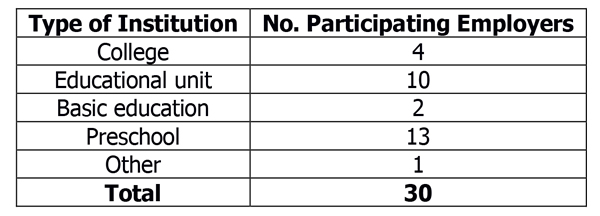
Source: Bello & Morales (2011).
The questionnaires are semi-structured or mixed (combining mostly closed and some open questions), and they were self- administered, using various strategies such as email, messenger companies and personal delivery.
According to the result of the expert opinion we consulted, the inventory was made up of 54 competences, as can be seen in the following table:
Table 3. Inventory of competences.

Source: Bello & Morales. (2011, pp. 354-355).
The other questionnaires were organized in two parts. In the first one, there are general aspects that would make it possible to describe the population, as well as to inquire about aspects related to Information and Communication Technologies. The second part was integrated with the inventory of the 54 competences and, so as to consult them, a Likert scale was established that sought to know the perception of professors, employers and students regarding the importance and development of each competence. The scale is from 1 to 4, where one reflected an unfavorable opinion and four the most favorable.
Subsequently, data were collected, involving 30 employers, 29 professors and 385 students. In short, the construction of instruments is summarized in the following image:
Source: Bello & Morales (2011).
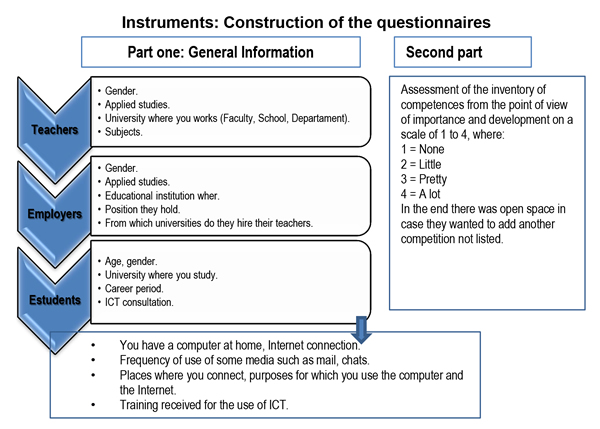
Figure 1: Instruments: Construction of questionnaires.
For the analysis of data, a mixed approach is used, in order to describe students’ competences for the use of Information and Communication technologies. Descriptive statistics, that is, frequency and percentage, were used in most of the questions. Contrasts were also made between the data obtained from the different groups from the level of importance and development of the competences with the interest if there was a relationship among them or not, so a correlation analysis between the three populations is made. For the open-ended questions, a content analysis was carried out according to their relationship with the theoretical framework.
The results are presented according to the operationalization of the main dimensions of the study, that is, they are described by categories based on the use of graphs and tables for each of the indicators and questions referred to. In accordance with the objectives we set, the results of each of the questionnaires are described, and the most important distinctions that have been found according to the sample are analyzed, to subsequently triangulate and compare all the collected information.
The phases of research were the following:
Source: Bello & Morales (2011, p. 326).
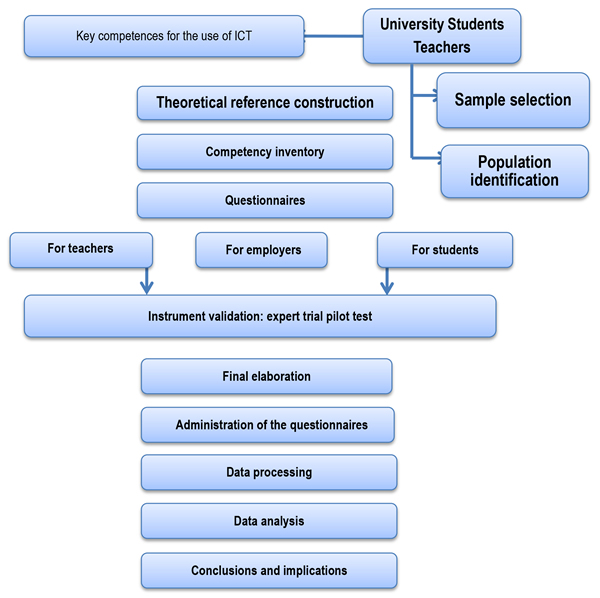
Figure 2: Phases of Research.
4. DISCUSSION
In order to be able to contrast and correlate the results we obtained, the generals that gave us initial information on each of the consulted populations are presented from four points of view, especially to know their habits and uses of ICTs. Secondly, the results of each of the populations were presented in detail, describing each competence individually from the level of importance and development. Thirdly, the globalized results were detailed according to the categories of competences, in order to describe the level of importance and development, and then they were compared among the data obtained of the different populations. Fourthly, the study of correlations was presented in order to determine the relationship or dependence between the importance and the development of the categories of competences we studied. The following image shows the aforementioned:
Source: Bello & Morales (2011).
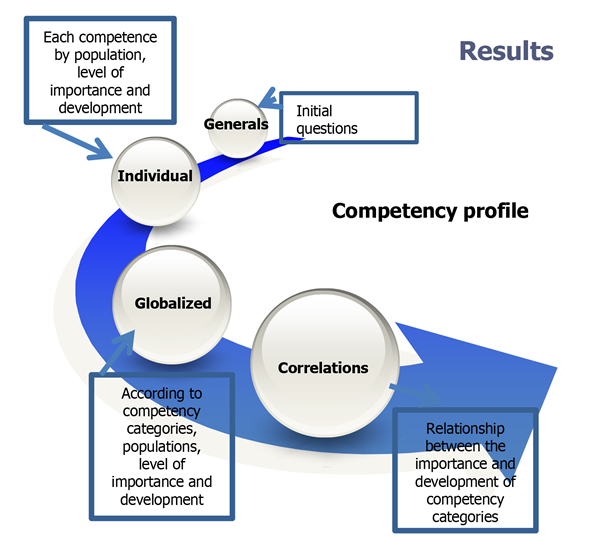
Figure 3: Analysis of Results.
Some of the most relevant results of this piece of research are described below and, for the purposes of publication, what the students expressed will be emphasized. When asked if they had an Internet connection at home, two hundred thirty-two (232) students answered yes, while one hundred fifty-three (153) answered no. In other words, 60.25% “Do” have Internet while 39%, 75% “Do not” have access to it. This indicates that not everyone who has a computer at home is connected to the Internet because the percentage decreases in this case by 17 points, in other words, out of 300 students who have a computer at home, only 232 connect to the Internet from their home. In Latin America in 2018 it is 66%, a figure that coincides with the results of the study. Contreras & Campa (2017) also point out that the majority of secondary school students in Mexico prefer to socialize through social networks most of their time, when they are not at school, the same teenagers said they were always in touch with their classmates and friends.
Today the Venezuelan population is more connected due to mobile phones, from which they access the internet and search for information quickly, and through the data plan to which they are affiliated. We cannot stop commenting that currently Venezuela is one of the countries with less freedom in the world, it is among the three nations with the worst internet connection, with numerous blocked pages, this being a human right declared in 2011 by The General Assembly of the United Nations Organization (UN) and its violation could be subject to international criminal sanctions (Martín, 2018). Students are asked about the frequency of uses of different media, such as the computer, Internet, Email and Chats on a scale that ranges from daily to never. According to the responses we received, in all cases the majority respond that they use them daily, the computer obtaining the highest score and Chats the lowest, as we can see in the following table:
Table 4. Frequency using the following means.

Source: Bello & Morales (2011, p. 373).
When students are consulted about the places where they usually use the computer and / or the Internet for the longest time, we find that in all universities the highest percentage of responses was at “Home” with 71.68% (276 students), secondly, “Cyber-café” with 16.88% (65 students) and thirdly “University” with 5.97% (23 students). The main use of the computer made by students is to make reports and work for the university, followed by listening to music, watching movies or consulting information, making designs and playing. As for the use of the Internet, they indicate that they use it mainly to find information necessary to do their work, then to interact with others and make friends, download music or movies and take online courses. Students consider that they have received training for the use of ICTs mainly through self-training, followed by university and in secondary education, noting that they qualify their training as good.
When consulting professors about the level of importance of the 54 competences, they consider that more than 83% as more significant are those associated with browsing and searching for information on the Internet, followed by the basic use of tools such as spreadsheets and the use of the internet to communicate, research, make reports, learn to obtain varied information. Regarding the development of competences, they indicate they have very much and quite a lot developed the competences related to the use of the Internet and ICT as a tool to communicate, research, build “products” (reports, papers, presentations, etc.), learn and obtain varied information since an average of 78.6% express it. They consider that the least developed competences are those associated with installing, uninstalling programs, configuring email, connecting a computer, using the advanced functions of spreadsheet programs.
Employers said that, to them, the most important competences are writing a document, using search engines, surfing the internet, finding information, using storage devices. Less important they consider to be those related to developing digital games, downloading programs, images, creating audio clips. As for the development of competences, the most relevant are writing a document, using search engines, using advanced functions of a word processing program such as Word, using the internet to search for information. They perceive that the least developed ones are applying instructional design elements, developing digital games, participating in distance courses and learning about electronic resources for teachers.
The three populations consider the following very important: everything related to the use of the internet to learn, research, communicate, build documents and get information for pedagogical practice, the use of word processors, spreadsheets and presentation editors. As for the less important, they consider those related to the design of web pages, creation of an audio clip, install or uninstall programs, configuration of emails and anti-virus programs, connect a computer. It is striking that employers and students place participation in discussion forums in the last places, and students point out the design of digital games.
In relation to the level of development of competences again, the three populations perceive that the one associated with using the Internet to obtain information is very advanced. They also consider the use of office programs to be highly developed, especially in terms of their basic functions. The competences associated with the communication and use of tools to find information are considered by everyone quite developed. In the last places, there are competences associated with judging or valuing, as well as critical capacity to contribute or improve. It can be noted that there are coincidences regarding the importance and level of development with competences related to the design of web pages, creation of audio clips, configuration of email and antivirus programs, as well as the installation or uninstallation of programs. It is noteworthy that students express they have poorly developed competences associated with distance education / e-learning, both in design and participation, as well as the development of digital games. There were coincidences regarding the fact that students in the education degree course have little knowledge of more technical aspects, such as installing or uninstalling computer programs or configuring email or an antivirus program. The fact that they are poorly trained in terms of the elements of an instructional design for the development of distance courses, or the use of electronic resources for pedagogical documentation is of concern. It is observed that there is possibly little interest in knowing more in depth tools such as spreadsheets or programs to create images and graphics such as Photoshop, and use of the online help manuals. It might be interesting to review and / or recommend that, in the syllabuses of Education degree courses, these aspects be taken into account where there is little or no training, especially in relation to the competences associated with the design of Web pages, creation of an audio clip, and the development of digital games using tools such as PowerPoint, Flash, Director, among others.
Another step we took to analyze the obtained data, the competences were organized in five categories and each one was defined. They were organized as follows:
Table 5. Organization of the Competitions in Categories.

Source: Bello & Morales (2011, p. 652).
Finally it was considered that it was of interest for this piece of research to study whether or not there is any kind of relationship between importance, as well as the development of competences according to the results obtained from the answers provided by professors, employers and students. For this piece of research, the coefficient of linear correlation was used (quotient between the covariance and the product of the standard deviations of both variables). In the correlations between the importance and the development of competences from the point of view of professors and students, it was observed that apparently there is no correlation between what they consider important and how developed the competition is. The population of employers seems to be a little more aware of the usefulness and importance of competences, as well as their development, that is, small correlations are observed, so this population seems to be a little clearer, it could be noted that in the labor world they are more interested both in the importance and in the development of ICT in the training of Venezuelan teachers. When analyzing the results obtained from the consultation of professors, employers and students regarding the importance and development of the competences for the use of ICT, an aspect of the culture of Venezuelans is somehow reflected, where they live day by day according to their circumstance. This is reflected in research conducted to know the personality of the Venezuelan, one is the “Poverty Project” (Ugalde, España, Lacruz, De Viana, González, Luengo and Ponce, 2004) and another is “Incidence of the Personality of the Venezuelan in the Determination of New Consumer Segments” (Cabrera, 2008).
5. CONCLUSIONS
During the development of this piece of research, the importance and relevant role that Information and Communication Technologies (ICT) have been taking in the world has been proven, especially in the educational area where they have taken a relevant role in University Education and especially in the design of programs and curricula for teacher training. In relation to the objective of researching the competences of university students in the pedagogy degree course for the management of ICT, we found that students think that all competences are relevant, because approximately 85% score them on the largest scale. The students consider that the five categories of competences are important, number one being the one that obtains the lowest score (Computer systems: Hardware, software, networks). Regarding the development of competences, the students have a diversity of opinion, since in general they perceive them as being little or quite developed. Almost half of them are marked at level “4” and, adding the two highest levels, it is obtained that approximately 38 competences are qualified as quiet and highly developed. The following table summarizes the students’ perception.
Table 6. Student conclusions.

Source: Bello & Morales (2011).
In relation to the consultation made to know the opinion of university professors of the pedagogy degree course about the competences that students require for the use of ICT, in general they express that they consider all important, giving a higher score to the categories two, that is, those associated with the use of the Internet, links or hyperlinks that appear on Web pages, use of search engines such as Google, Yahoo, etc., communication with other people through email, chat, instant messaging, discussion forums, blogs, among others. In other words, those corresponding to those related to “Tools for communication, information and research”. As for the development of competences, they again indicate with greater punctuation the same competences associated with category two, and the least worked are those associated with computer systems. The following table summarizes the opinions of professors.
Table 7. Teacher conclusions.
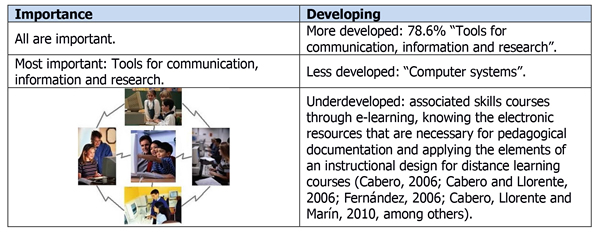
Source: Bello & Morales (2011).
En relation to the objective of exploring the opinion of employers regarding the competences required by graduates in pedagogy for the use of ICT, it is perceived that, as regards importance, slightly more than 67% consider that 29 of the 58 competences are very relevant. Like the other populations, they also consider the five important categories, giving the highest score to two, three and four. In terms of development, employers have opinions with a tendency towards competences being quite developed and scarcely developed. The following table summarizes their opinions.
Table 8. Employer conclusions.

Source: Bello & Morales (2011).
When perceptions are compared from the point of view of the importance of each of the categories of competences, it is observed that all populations consider them important, and they are then ordered from those of less importance (below) to those of greater importance (above).
Source: Bello & Morales (2011).
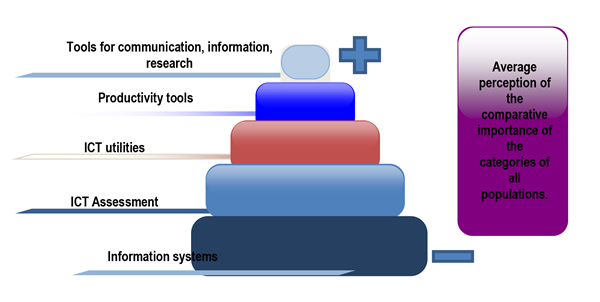
Figure 4: Level of importance of the categories.
When comparing perceptions from the point of view of development, there are differences in opinion:
In relation to the statistical study of correlations, it is obtained that the results are consistent in the sense that everyone says exactly the same thing, and there are no correlations between the importance and the development of competences by the students in the pedagogy degree course for the use of Information and Communication Technologies (ICT).
Next and in accordance with the last specific objective of this piece of research, a proposal of the profile of key competences required by the students in the pedagogy degree course for the management of Information and Communication Technologies (ICT) is presented, which could be considered in future designs of syllabuses and teacher training programs, mainly in venezuelan universities:
Table 9. Key competencies profile.
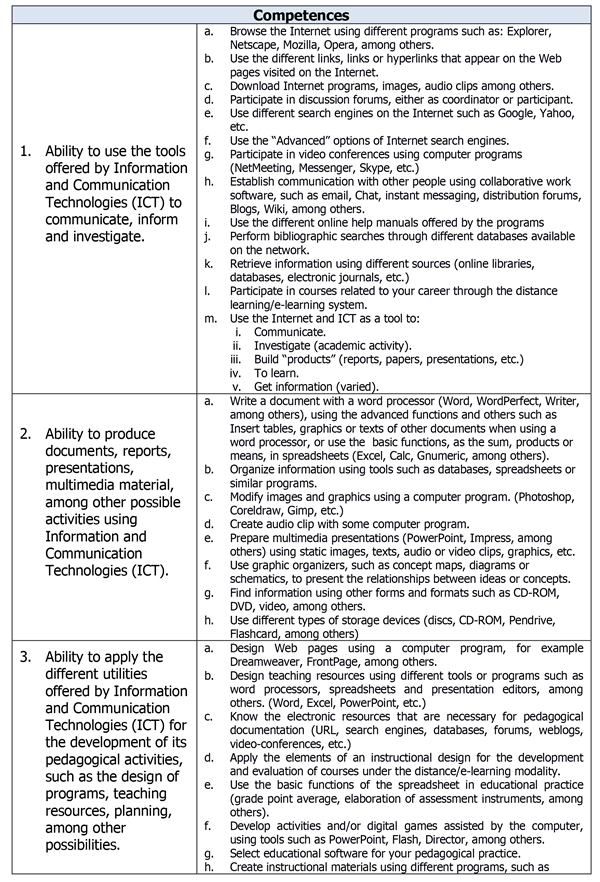
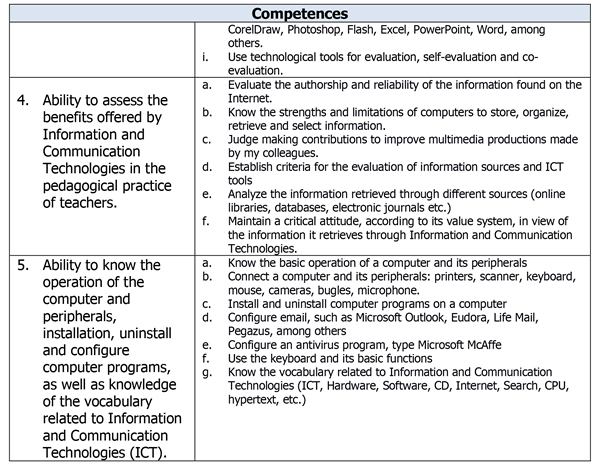
Source: Bello & Morales (2011).
REFERENCES
AUTHORS
María Eugenia Bello van der Ree: Doctor in Didactics and Organization of Educational Institutions of the University of Seville, Spain. Master in Education of young children at Stanford University, United States and Bachelor of Education, mention Pedagogical Sciences of the Andrés Bello Catholic University, Venezuela. She has worked at the Metropolitan University in Caracas, Venezuela since 1982, as a part-time teacher and since 2000 as a full-time teacher in the Department of Education Sciences, she has served as academic manager as Coordinator of the Specialization in Institutional Management Educational, Director of the School of Education and currently Dean of General and Basic Training. Part-time professor at Andrés Bello Catholic University, School of Education, since 1999.
mabello@unimet.edu.ve
Orcid ID: http://orcid.org/0000-0002-2183-7542
ResearchGate: https://www.researchgate.net/profile/Maria_Bello8
Juan Antonio Morales Lozano: University Professor attached to the Department of Didactics and Educational Organization of the University of Seville. Member of the Didactic Research Group (Andalusian Research Plan: HUM390). Teaching activity in studies of Degree (Teacher and Pedagogy), Master (Management, Evaluation and Quality of Educational Institutions and Training and Orientation for Work) and Doctorate in Education.
jamorales@us.es
Orcid ID: https://orcid.org/0000-0003-1462-233X
Researcher Id: http://www.researcherid.com/rid/E-6114-2012
ScopusID: https://www.scopus.com/authid/detail.uri?authorId=36020200800
Dialnet: https://dialnet.unirioja.es/servlet/autor?codigo=254115
Más información en: http://investigacion.us.es/sisius/sis_showpub.php?idpers=1950